Tested Diesel Tough
Gear Star Builds a Bulletproof 4L80E
By Kevin Wilson
Before the advent of the Allison automatic transmission in diesel-equipped GM vehicles, the toughest transmission in GM's arsenal was the 4L80E. Used on the early Duramax trucks, the 4L80E was also bolted behind big-block gas motors and used extensively on the HD line of pickups. It's a solid transmission that has gained favor with the transplant crowd and can easily be bolted behind a Cummins with an adapter.
The key to making a transmission bulletproof is to use top quality components that work in unison. That's why Gear Star Performance Transmissions out of Akron, Ohio, has built a solid reputation on building diesel transmissions that can hold up to the heavy torque loads applied to today's diesel power-plants.
Gear Star builds every transmission to customer specifications and each transmission is built start to finish by only one technician. The beauty of the "one tech for every transmission system" that Gear Star employs is that other hands do not muddle the technician's work. Another unique Gear Star quality is that the company replaces all the components inside the transmission wether they need it or not, so when your transmission comes back, it's all new from one end to the other.
For diesel transmission, Gear Star utilizes cryogenically hardened and stress-relieved, or custom manufactured 300M billet steel components, fresh Kevlar or carbon fiber clutches, hardened Kollen steels, Alto Red Eagle Racing Friction clutches with increased surface area for less slippage. Slippage creates heat and that's what kills most automatics. The company also offers billet torque converters and custom builds for extra heavy-duty use.
The transmission seen here is headed for a mid-80's Chevy stuffed with a 12-valve Cummins turbodiesel. Originally, the Chevy was fitted with a TH400 3-speed automatic but with 4:10 gears in the rear end, Gear Star recommended the 4L80E for a lower first gear and an overdrive for lower rpms on the freeway and better mpg.
The following photos highlight the transmission build-up process. Part 2 of our "Built Diesel Tough" story will cover the install behind the Cummins and Gear Star's trick stand-alone controller that will be necessary on the diesel. If you're in the market for a custom-built automatic, then check with the experts at Gear Star before dumping a new slush-box into your diesel.
 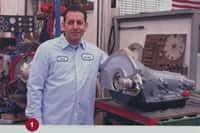 |
Nothing takes a beating on a diesel truck more than the automatic transmission. Crank up the power on the engine, and the transmission can easily become the weak link in the drivetrain. |
| Gear Star custom builds each transmission to the customer's specifications, which is especially important to the diesel guy. | 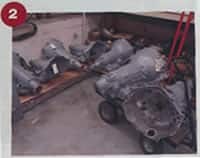  |
  |
Each Gear Star transmission is Dyno tested. Each tranny is put through a series of tests based of its build requirement. After the 220-Hp dyno run, the unit is drained, cleaning the system of assembly lube.. |
| Three different valve body configurations help to make four performance levels to fit most any need, including that of pullers, drag racers and folks who tow. | 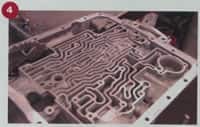  |
 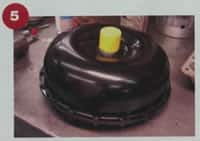 |
Much like the unspoken magic of a Funny Car clutch, the torque converter setup dictates how the engine power is transferred to the other drive components. |
| Gear Star uses high quality synthetic ATF lubricating fluid to extend the transmission's life. With a housing full of fresh CNC 300M billet steel parts, it's a good idea to make sure you keep thermal expansion from friction under control. Gear Star uses synthetic tranny fluid to control heat developed by friction. |   |
 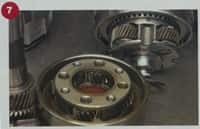 |
Because the 4L80E has been in service since the mid '90s, it's gone through three generations of changes. The latest rendition of GM's heavy gas hauler trans is known as the 4L85E. With it comes some substantial strength changes. Gear Star upgrades all of its Stage III 4L80E transmissions with all the 4L85E benefits, such as this planetary segment shown here. Most planetary assemblies use four planet center section. The 4L85E uses a fifth planet to provide additional gear contact and added gear surface contact. This spreads the load over the added gear contact providing strength. Gear Star cryogenically treats many of the hard parts, such as the planetary assemblies for bulletproof strength. |
| All of the bearings that are the liaisons between cryogenic and billet 300M material are built to accommodate the different thermal expansion rates between the two materials. Gear Star has these bearings made so an occasional added benefit will also be incorporated into the bearing design. Shown here are grooves that provide additional lubrication to the planetary gears. |   |
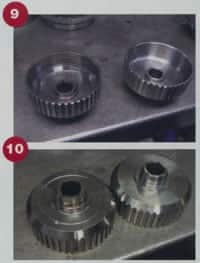 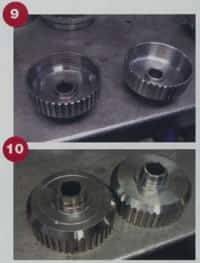 |
On the left is the stock hub. Gear Star's Level 111 is upgrade with their 300M billet steel unit. 300M steel is made of carbon, chromium, iron, manganese, molybdenum, nickel, phosphorus, silicon, sulphur, and vanadium. A specific mixture of these elements are melted under vacuum and quenched to form a low alloy steel of very high strength. It's basically 4340 forged steel with a bit more silicon, vanadium, carbon, and molybdenum content than 4340. 300M provides incredible strength, resists fatigue, yet till has excellent choice for loads bearing 280-ksi to 305-ksi. A ksi is about 1,000 per square inch, so in reference 300M can sustain 287,247-psi to 305,014-psi. Many bearings in a stock 4L80E are a coated aluminum, which makes it cheaper to mass manufacture. This is another component that doesn't play well with power. Gear Star converts all of these bearings to brass. |
| Many bearings in a stock 4L80E are a coated aluminum, which makes it cheaper to mass manufacture. This is another component that doesn't play well with power. Gear Star converts all of these bearings to brass. |   |
 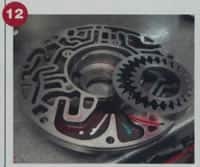 |
The pump body is ported to increase the pump's volume output. Pump volume is realative to line preasure, so these modifications also increase the transmission's ability to generate pressure. |
| With Gear Star's success in the strength of it's Stage III 4L80E, there is enough interest in the Stage III that Gear Star has built adapters so it can be used for most any domestic powerplant including diesels. | 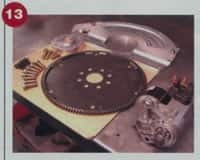  |
  |
Because each trans is built to spec, every Gear Star tranny is disassembled and rebuilt by one tech. No parts are reused in the builds, and as you'd expect, all of the bushings, seals, rings, and gaskets are replaced as well, including a few other parts like the all-new sensors from GM. |
| Here the cryo-treated drum is fitted with the custom-built 300M input shaft with a custom bearing for expansion. The precision 300M splined shaft mates perfectly to the drum. With the pump body modified for added pressure and flow, the fitment of the splines is set so the expansion deferential between the materials with the added lubricity doesn't allow them to grow and gall to one another. |  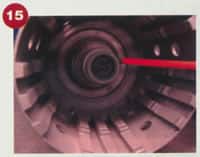 |
 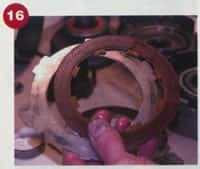 |
The stock clutch pack uses a two-stage clutch that provides a progressive trans engagement. While great for that smooth shift grandma likes, it doesn't pay homage to the performance-minded positive feedback provided by a firm shift. |
| To address the issue of less efficient clutch material Gear Star uses Alto Red Eagle racing Frictions, Raybestos Gen ll Racing Blues or hardened Kollen steel clutch plates. Some clutch hubs are re-machined or custom manufactured to increase the number of clutches and plates. At a minimum, the transmission's clutch engagement surface is increased by 60 percent. | 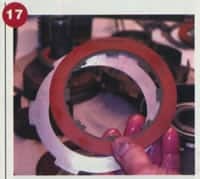  |
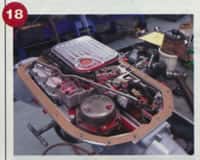 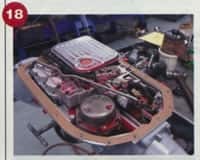 |
Should your trans be ordered with a deep pan, the pickup tube will be customized by moving the filter deeper into the pan; this ensures that the transmission draws the coolest fluid in the pan. |
| Gear Star uses Yank torque converters to complete their upper level tranny builds. Yank's Truck Thrusters are not a retooled or re-stalled version of the stock GM converter, but a brand new design that is a Yank exclusive! The 278mm (11 inches) size is slightly smaller than the stock 300mm (12 inches) and has substantially different driving characteristics. The maximum stall on a factory GM 5.3L torque converter is 1,600 RPMs and the shifts drop about 2,600 RPMs between shifts. With the new Yank Truck Thruster 2600 torque converter, your 5.3 engine will now stall at 2,600 RPMs and the 2.1 Stall Torque Ratio (STR) will multiply more starting line torque than the factory 1.9 STR. This'll shave anywhere from 0.3-0.4 seconds off your 0-60 E.T.s. | 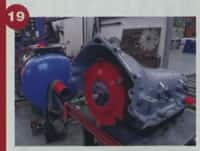 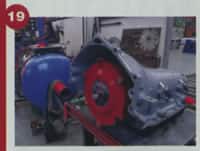 |
